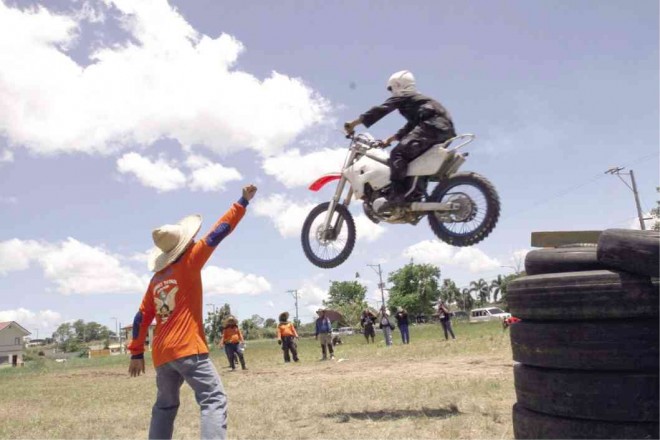
THE FINAL test in the motorcycle-riding course of the Quezon police includes a 5-foot high jump from an improvised wooden ramp stacked over piles of rubber tires. DELFIN T. MALLARI JR./INQUIRER SOUTHERN LUZON
LUCENA CITY—When Police Officer 1 Paul Jason Sison registered in February for a 45-day motorcycle-riding course, he did not know how to start a motorcycle, much more drive a two-wheel vehicle.
But on April 3, on a grassy vacant lot of a subdivision in the outskirts of this city under the noonday sun, the rookie policeman successfully hurdled the course’s final test—a 5-foot high jump from an improvised wooded ramp stacked over piles of rubber tires—and gracefully landed safely amid the shouts and applause of his trainers and fellow course participants.
“I’m very happy. I finally made it,” Sison, 28, told the Inquirer after his second and final successful jump.
A course participant must successfully hurdle the final jump twice to pass the last test of the training. After hurdling the jump, the ecstatic rider threw his helmet in the air as part of tradition.
Sison, who hails from San Narciso town, Quezon province, said he didn’t know how to ride the two-wheel vehicle when he entered the course. “But I wanted to learn, so I joined the course. I’m glad that I successfully hurdled all the challenges and hardship during training,” Sison said, as he expressed gratitude to all the training instructors.
He expressed confidence that he could now execute also the riding techniques of professional motorcycle policemen. “But I have to first save money to buy my own big bike,” he said with a laugh.
Focus
The course is “very rigid and difficult,” said course director Chief Insp. Peter Dionisio of the Philippine National Police Highway Patrol Group (PNP-HPG) based in Camp Vicente Lim in Barangay (village) Canlubang, Laguna province. If the rider is not focused and improperly trained, he can sustain serious bruises. “And when one falls from the motorcycle and suffers injuries, the rider can become comatose; some even die,” Dionisio said.
He said the most important part of the course was to inculcate self-discipline in the mind of every rider.
Some family members of participants nervously watched under a huge tent as their loved ones took their final jumps.
Babylyn Cada, wife of police officer Edison Cada, said she was nervously praying while her husband was taking his jumps. “I gave him a hug and a kiss after his successful jumps. Becoming a certified rider is his dream,” she told the Inquirer.
During the final jump test, an ambulance and a first aid team were on standby to attend to any emergency. One of the trainees who suffered injuries from a fall was brought to the hospital after completing his second jump.
Dionisio brought along instructors from the PNP-HPG and was also assisted by five motorcycle cops from the Lucena City police stations, all graduates of the course.
“Once they finish the course, they are what we call in the force legitimate ‘hagad’ (Filipino slang for a motorcycle-riding cop),” Dionisio said.
Senior Supt. Ronaldo Genaro Ylagan, Quezon police chief, said the motorcycle-riding course among policemen was the first in the province.
Most participants originate from different police stations in Quezon, particularly those with government-issued motorcycles.
The training funds were provided by the provincial police office and the different local police stations.
Advantage
“Knowledge of advance motorcycle-riding techniques will be useful in anticrime operations, especially against motorcycle-riding criminals,” said Ylagan, also a graduate of the course in 2012.
The training provides participants with basic scientific motorcycle-riding techniques, correct riding posture, confidence in riding, jumping, long-ride and the do’s and don’ts of big bike riding.
The course also teaches participants to learn how to control their motorcycles during rainy and slippery situations, and when passing through congested traffic, as well as hazard awareness.